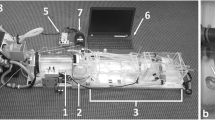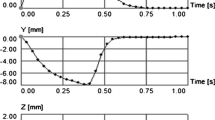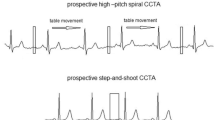Abstract
To investigate the feasibility of contrast media (CM) volume reduction in dual-source coronary computed tomography angiography high-pitch mode without affecting coronary artery enhancement. Eighty patients were involved in a preliminary experiment with a default injection protocol (60 ml of CM). The age, BMI, test bolus (TB) enhancement peak and the CT values of coronary artery for each patient were recorded and the key factors for determining coronary artery enhancement were investigated. Based on the results of the preliminary experiment, 120 patients were involved in the main experiment with a new injection protocol. For each patient, the CT values and noise of left coronary sinus (LCS), and the distal segment of right coronary artery were measured. In the preliminary experiment, the peak enhancement of TB correlated most strongly with the HU values of coronary artery. Consequently, the new injection protocol was devised to catalog patients into four groups (30, 40, 50 and 60 ml) of CM based on their TB peak enhancement. In the main experiment, the 30 ml CM injection group whose peak attenuation of TB were the highest (30 vs. 40,50,60 ml: 323.0 ± 27.5 vs. 264.2 ± 11.9, 242.1 ± 8.8, 206.2 ± 18.2 HU, p < 0.05), obtained the highest attenuation of LCS (30 vs. 40,50,60 ml: 365.0 ± 41.2 vs. 341.8 ± 40.0, 326.9 ± 34.7, 312.5 ± 38.2 HU p < 0.05). Contrast optimization is feasible in high-pitch DSCT coronary angiography. Certain patients may receive 30 ml of CM without affecting vessel enhancement.




Similar content being viewed by others
References
Ehara M, Surmely JF, Kawai M et al (2006) Diagnostic accuracy of 64-slice computed tomography for detecting angiographically significant coronary artery restenosis in an unselected consecutive patient population: comparison with conventional invasive angiography. Circ J 70:564–571
Garcia MJ, Lessick J, Hoffmann MH (2006) CATSCAN study investigators accuracy of 16-row multidetector computed tomography for the assessment of coronary artery stenosis. JAMA 296:403–411
Nikolaou K, Rist C, Wintersperger BJ et al (2006) Clinical value of MDCT in the diagnosis of coronary artery disease in patients with a low pretest likelihood of significant disease. Am J Roentgenol 186:1659–1668
Muhlenbruch G, Seyfarth T, Soo CS et al (2007) Diagnostic value of 64-slice multidetector row cardiac CTA in symptomatic patients. Eur Radiol 17:603–609
Mann JF, Gerstein HC, Yi QL et al (2003) Development of renal disease in people at high cardiovascular risk: results of the HOPE randomized trial. J Am Soc Nephrol 14:641–647
Finn WF (2006) The clinical and renal consequences of contrast-induced nephropathy. Nephrol Dial Transplant 21:2–10
From AM, Bartholmai BJ, Williams AW et al (2008) Mortality associated with nephropathy after radiographic contrast exposure. Mayo Clin Proc 83:1095–1100
Toprak O (2007) Conflicting and new risk factors for contrast induced nephropathy. J Urol 178:2277–2283
Mann JF, Gerstein HC, Yi QL et al (2003) Development of renal disease in people at high cardiovascular risk: results of the HOPE randomized trial. J Am Soc Nephrol 14:641–647
Rist C, Nikolaou K, Kirchin MA et al (2006) Contrast bolus optimization for cardiac 16-slice computed tomography: comparison of contrast medium formulations containing 300 and 400 mg of iodine per milliliter. Invest Radiol 41:460–467
Cademartiri F, Mollet NR, van der Lugt A et al (2005) Intravenous contrast material administration at helical 16-detector row CT coronary angiography: effect of iodine concentration on vascular attenuation. Radiology 236:661–665
Cademartiri F, de Monye C, Pugliese F et al (2006) High iodine concentration contrast material for noninvasive multislice computed tomography coronary angiography: iopromide 370 versus iomeprol 400. Invest Radiol 41:349–353
Cademartiri F, Maffei E, Palumbo AA et al (2008) Influence of intra-coronary enhancement on diagnostic accuracy with 64-slice CT coronary angiography. Eur Radiol 18(3):576–583
Fleischmann D (2003) High-concentration contrast media in MDCT angiography:principles and rationale. Eur Radiol 13(Suppl. 3):N39–N43
Sakai S, Yabuuchi H, Chishaki A et al (2010) Effect of cardiac function on aortic peak time and peak enhancement during coronary CT angiography. Eur J Radiol 75(2):173–177. (Epub 2009 May 13)
Dewey M (2009) Coronary CT Angiography. Springer-Verlag, Berlin Heidelberg, ISBN 9783540798439
Rybicki FJ, Otero HJ, Steigner ML et al (2008) Initial evaluation of coronary images from 320-detector row computed tomography. Int J Cardiovasc Imaging 24:535–546
Steigner ML, Otero HJ, Cai T et al (2009) Narrowing the phase window width in prospectively ECG-gated single heart beat 320-detector row coronary CT angiography. Int J Cardiovasc Imaging 25(1):85–90
Kumamaru KK, Steigner ML, Soga S et al (2011) Coronary enhancement for prospective ECG-gated single R–R axial 320-detector row coronary computed tomography angiography: comparison of 60 and 80 ml iopamidol-370 contrast medium injection. Am J Roentgenol 197(4):844–850
Van Hoe L, Marchal G, Baert AL et al (1995) Determination of scan delay-time in spiral CT-angiography: utility of a test bolus injection. J Comput Assist Tomogr 19(2):216–220
Nakaura T, Awai K, Yauaga Y et al (2008) Contrast injection protocols for coronary computed tomography angiography using a 64-detector scanner: comparison between patient weight adjusted-and fixed iodine-dose protocols. Invest Radiol 43:512–519
Yamamuro M, Tadamura E, Kanao S et al (2007) Coronary angiography by 64-detector row computed tomography using low dose of contrast material with saline chaser: influence of total injection volume on vessel attenuation. J Comput Assist Tomogr 31:272–280
Tatsugami F, Matsuki M, Inada Y et al (2010) Feasibility of low-volume injections of contrast material with a body weight-adapted iodine-dose protocol in 320-detector row coronary CT angiography. Acad Radiol 17(2):207–211. (Epub 2009 Nov 17)
Ho LM, Nelson RC, DeLong DM (2007) Determining contrast medium dose and rate on basis of lean body weight: does this strategy improve patient-to patient uniformity of hepatic enhancement during multi-detector row CT? Radiology 243:431–437
Hittmair K, Fleischmann D (2001) Accuracy of predicting and controlling time-dependent aortic enhancement from a test bolus injection. J Comput Assist Tomogr 25(2):287–294
Steigner MT, Mitsouras D, Whitmore AG et al (2010) Iodinated contrast opacification gradients in normal coronary arteries imaged with prospectively ECG-gated single heart beat 320-detector row computed tomography. Circ Cardiovasc Imaging 3(2):179–186
Rybicki FJ, Melchionna S, Mitsouras D et al (2009) Prediction of coronary artery plaque progression and potential rupture from 320-detector row prospectively ECG-gated single heart beat CT angiography: Lattice Boltzmann evaluation of endothelial shear stress. Int J Cardiovasc Imaging 25:289–299
Melchionna S, Bernaschi M, Succi S et al (2010) Hydrokinetic approach to large-scale cardiovascular blood flow. Comput Phys Commun 181:462–472
Conflict of interest
None.
Author information
Authors and Affiliations
Corresponding author
Rights and permissions
About this article
Cite this article
Yang, W.J., Chen, K.M., Liu, B. et al. Contrast media volume optimization in high-pitch dual-source CT coronary angiography: feasibility study. Int J Cardiovasc Imaging 29, 245–252 (2013). https://doi.org/10.1007/s10554-012-0068-7
Received:
Accepted:
Published:
Issue Date:
DOI: https://doi.org/10.1007/s10554-012-0068-7




